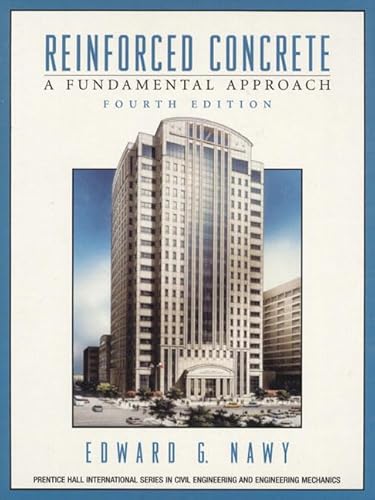
Synopsis
Designed for senior undergraduate/graduate level Civil Engineering courses.
Extensively revised to reflect the new ACI 318 Building Code, this cutting-edge text analyzes the design of reinforced concrete members through a unique and practical step-by-step trial and adjustment procedure. Supplementing text material with flow charts to logically guide students through the learning process, the book decreases the necessity of actual laboratory testing by offering ample photographs of instructional testing of concrete members. This illustrates the failure of various types of structural members as well as demonstrates how the designed member behaves at ultimate load.
"synopsis" may belong to another edition of this title.
About the Author
DR. EDWARD G. NAWY, distinguished professor in the Department of Civil and Environmental Engineering at Rutgers, The State University of New Jersey, has been active in the ACI and PCI since 1949 and is internationally recognized for his extensive research work in the fields of reinforced and prestressed concrete, particularly in the areas of serviceability and crack control. Dr. Nawy's work has been published in technical journals worldwide (over 160 technical papers). He is the author of Simplified Reinforced Concrete (1986), Prestressed Concrete (3rd Ed., 2000), both published by Prentice Hall, High Strength High Concrete Construction Engineering Handbook (1998) published by CRC Press. He is recipient of several major awards, including the Henry L. Kennedy Award of the American Concrete Institute, is a licensed Professional Engineer in the States of New York, New Jersey, Pennsylvania, California and Florida, Evaluator for the Accreditation Board for Engineering and Technology (ABET), and has been a consultant in structural engineering throughout the United States.
From the Back Cover
This new edition of Edward G. Nawy's highly acclaimed work reflects the very latest ACI-99 Building Code and includes these major changes and additions:
- Numerous alternate solutions using SI Units and lists of equations in SI format for the various topics
- A completely rewritten chapter on seismic design of buildings to comply with the major changes in the ACT 318 Code and detailing the new International Building Code provisions (IBC 2000) on seismic design which replaced all other existing codes in the US. The chapter has several new examples on confinement, shear wall design, and detailing in accordance with the IBC 2000 Code
- A new section with design examples on the new provisions for crack control
- a new section on flexure using the limits strain approach of Appendix B in the ACI Code. All examples in the previous edition using the standard stress approach have also been solved by the strain limits approach
- A new section on biaxial bending with new design examples using the reciprocal load approach as well as an easier to use Modified Load Contour method
- A comprehensive chapter on concrete materials and design of concrete mixtures for normal strength and for high strength, high performance concretes
A self-contained textbook, it can be used for a one-semester undergraduate level course and a one-semester graduate level course in reinforced concrete in standard civil engineering programs.
It is equally useful for the practicing engineer. It is the only book that closely and systematically uses and follows procedures in numerous flowcharts within each chapter that simplify the understanding and application of the subject design.
This volume provides thorough coverage of short and long term material behavior, design of concrete mixtures, reliability and structural safety, serviceability behavior of beams and two-way slabs and plate systems, continuity in concrete structures, and seismic design of high rise buildings in earthquake zones.
It has an appendix on computer programs in Q-Basic, with typical program documentation and solutions, and an extended appendix of monograms and tables. Comprehensive sketches and sets of working drawings, end-of-chapter problems, pictures of actual structural tests to failure, and flowcharts appear throughout the book.
"About this title" may belong to another edition of this title.
Other Popular Editions of the Same Title
Search results for Reinforced Concrete: A Fundamental Approach
Reinforced Concrete: A Fundamental Approach (4th Edition)
Seller: HPB-Red, Dallas, TX, U.S.A.
Hardcover. Condition: Good. Connecting readers with great books since 1972! Used textbooks may not include companion materials such as access codes, etc. May have some wear or writing/highlighting. We ship orders daily and Customer Service is our top priority! Seller Inventory # S_388462143
Reinforced Concrete: A Fundamental Approach (4th Edition)
Seller: ThriftBooks-Dallas, Dallas, TX, U.S.A.
Hardcover. Condition: Very Good. No Jacket. Missing dust jacket; May have limited writing in cover pages. Pages are unmarked. ~ ThriftBooks: Read More, Spend Less. Seller Inventory # G0130205923I4N01
Reinforced Concrete: A Fundamental Approach (4th Edition)
Seller: World of Books (was SecondSale), Montgomery, IL, U.S.A.
Condition: Good. Item in good condition. Textbooks may not include supplemental items i.e. CDs, access codes etc. Seller Inventory # 00041657065
Reinforced Concrete: A Fundamental Approach (4th Edition)
Seller: World of Books (was SecondSale), Montgomery, IL, U.S.A.
Condition: Very Good. Item in very good condition! Textbooks may not include supplemental items i.e. CDs, access codes etc. Seller Inventory # 00082229362

